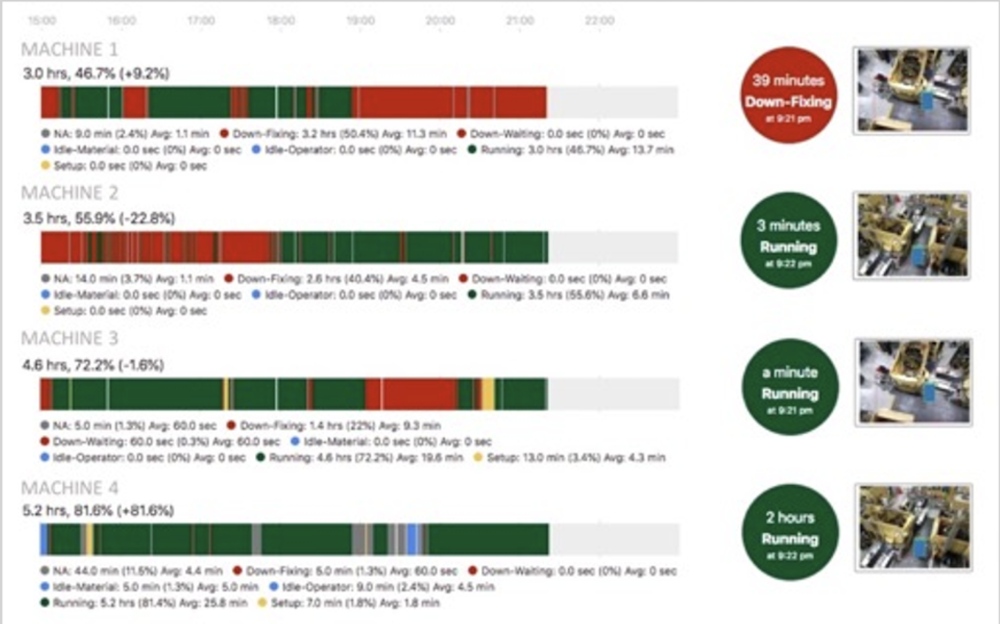
In any manufacturing industry, time equals money. Efficiency is key. The more efficient a manufacturing operation, the less downtime and waste, the greater the productivity and profitability.
Increasing machine utilization is essential to maximizing production efficiency, productivity, and profitability, but many manufacturers aren’t capturing the right data the right way for viable machine utilization improvements. There is a solution, however: discrete manufacturing analytics.
Discrete Manufacturing Analytics - For The Full Picture Of Machine Utilization
Put simply, machine utilization is a measure of how effectively a machine is being used. If machines are not being utilized effectively, it can lead to wasted resources, including raw materials, energy, and labor. Underused machines can cause overhead costs to rise, inventory bottlenecks, delayed deliveries, even spurring the purchasing of more equipment to keep up with demand.
Poor machine utilization can be exacerbated by:
- Too much lag time between a problem occurring and the discovery of that problem
- Problems that go undetected, becoming blind spots for manufacturers
- Multiple undetected problems occurring in multiple places, compounding inefficiencies
What might be surprising to some is that the top reasons for poor machine utilization are actually not machine-related — rather, they involve a variety of people issues. How people interact with the machines they are operating is a major factor in machine downtimes, but most shops don’t have the tools that will effectively capture data around these interactions. Too many traditional tools and even modern technologies only capture machine data.
Top shops with higher machine utilization generate greater profits — but they don’t achieve this higher machine utilization because they have larger shops or better equipment.
The key is in discrete manufacturing analytics. Discrete manufacturing analytics can bring previously obscured issues to light, providing a complete story of manufacturing operations. Real-time, digital feedback is gathered automatically and displayed simultaneously — not only machine-related data, but also of the critical elements of materials and people.
Computer vision technology uses artificial intelligence (AI) to constantly but passively monitor the shop floor, capturing data around people, the materials they work with, and the status of machines, and providing manufacturers with a visual stream of up-to-date, actionable intelligence. This digital feedback is delivered directly to all members of an operational team on the spot, with real-time alerts so that issues can be immediately identified and resolved. Not only that, discrete manufacturing analytics can deliver data-driven recommendations for continuous improvement in machine utilization going forward.
Discrete Manufacturing Analytics Can Allow Manufacturers To See
- Machine downtime, material absence, or underused assets
- Bottlenecks and idle time inhibiting productivity
- The current state of all machines true productivity
- The state of all machines productivity over time
- The percentage of shifts that are productive
- An unbiased comparison of productivity between shifts and between machines of similar type
- An unbiased breakdown of setup time vs run time of machines
Blind spots around machine utilization can cause a manufacturing operation a variety of issues that can become progressively worse over time — but blind spots can be illuminated and problems resolved much faster with the right tools in place. Computer vision and discrete manufacturing analytics play an important role in providing actionable insights into the crucial interaction between machines or vehicles, materials, and the people that handle them — helping to improve machine utilization in all types of work centers.
Overall, poor machine utilization can have a significant impact on a company's bottom line. Maximizing machine utilization is critical to staying competitive, producing more, high-quality products in less time, with lower costs. Discrete manufacturing analytics provides a better solution, giving manufacturers a complete picture so they can quickly address inefficiencies, optimize operations, and improve overall performance.
Maximize Machine Utilization With A Better Discrete Manufacturing Software Solution
Previously available traditional tools and solutions don’t provide the global view of operations manufacturers need to maximize machine utilization.
ThinkIQ’s Discrete software solution gives managers up-to-the-minute reporting on critical activities and events in their shops — by measuring machines and equipment (utilization) and people (efficiency), true productivity is captured for the first time. Access to full picture, real-time actionable intelligence enables manufacturers to take immediate action to correct any operational issues and get back to full production faster.
What’s more, ThinkIQ’s sensor devices can be installed in minutes, without the need for IT support or changes to existing processes — and with no machine downtime. As soon as the first week, manufacturers will already begin to discover insights that lead to a more efficient, productive, profitable enterprise.
There’s a better way to improve operational efficiency — Reach out to a ThinkIQ expert today to start increasing your machine utilization with our Discrete software solution. You can also download our new eBook, “Using Computer Vision to Fill Manufacturing and Warehousing Blind Spots with Actionable Data” to learn more about how to gain greater visibility into your manufacturing process.


